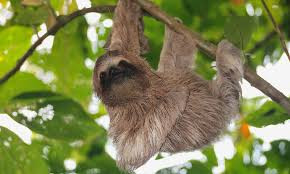Fascinating facts about Sloths

I recently came across this animal named ‘Sloth’. My instant reaction hearing the name of this animal was that when humans can’t be addressed based on their disabilities, rather use replacements for such derogatory words to make it sound agreeable, how can we take animals for granted and call them by their perceived ‘weakness’. The more I dug deeper to learn about Sloth's features, I understood that their slowness was not its weakness but rather its surviving strategy!! True to the dictionary meaning of the word Sloth, which is ‘reluctance to work or make an effort; laziness’, sloths are slow moving creatures. With strong arms, they hang upside down clinging onto tree branches in tropical American forests. And guess what?! They climb down the trees only to defecate once in a week.
So, the natural question would be: Does the sloth eat only once in a week? Sloth is a mammal which is a leaf-eater and for binge eaters like me (or us?! :D), the rate of digestion is just incredible. An estimation as studied by the researcher Becky Cliffe reveals that the approximate time taken for the food to move from ingestion stage to excretion range from 157 hours to a staggering 50 days (1,200 hours).
Another interesting fact about this animal is that they don’t expend much energy at all, sleeping for almost 10 hours a day, which means all days are Sundays for sloths. How we wish we were belonging to that species!! So, the slowness in its movement is pretty much understandable – slow rate of defecation, low caloric food (leaves), leaving it with little energy to expend and the resultant slow movements. Now, the next question that pops up is, for a cute animal like sloth, living in dense forests, how does it defend itself from its predators, for it can’t even walk faster, imagine running when a leopard chases it ferociously. Here again, Ms Becky throws a light on how slowness plays to its strength-
their survival is entirely dependent upon camouflage – a factor aided by their symbiotic relationship with algae growing on their fur. Sloths’ main predators – big cats like jaguars, ocelots and birds such as harpy eagles – all primarily detect their prey visually, and it is likely that sloths simply move at a pace that doesn’t get them noticed.
It is said that the sloths gain their share of protein from the algae growing on their fluffy fur, which is almost water resistant and impedes the attack of parasites. Fascinating, isn’t it, to know that each creature on Earth is bestowed with carefully chosen features that would facilitate its survival!
With every creation of the Supreme that we surround us, one thing is clear. All creatures have a place on earth and each except one species (you know which is that :D) does its designated job at its own pace, not being greedy to stock up more than what is required and doesn’t infringe upon other’s livelihood. There is so much to learn if (only) we look around and observe. Wouldn’t life be merrier if we were to live and let live like creatures such as sloth teaches us?
Newsletter
About Sammy's MindChirps
Hello! Welcome to Sammy's MindChirps. I'm glad you are here. To me, the word LIFE is an acronym of Laboratory with Infinite Freedom to Experiment. It's more like a kaleidoscope offering amazing learning opportunities as we grow and explore various facets of life. So this blog is a platform where I share anything that I find interesting (with my two cents, of course :D). I assure that you will have some new learning when you exit the blog. And do share your feeback on the blog or anything you want me to write about in this blog by dropping an email to mindchirps@gmail.com